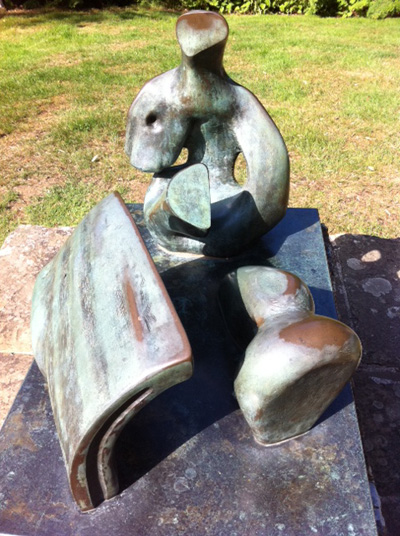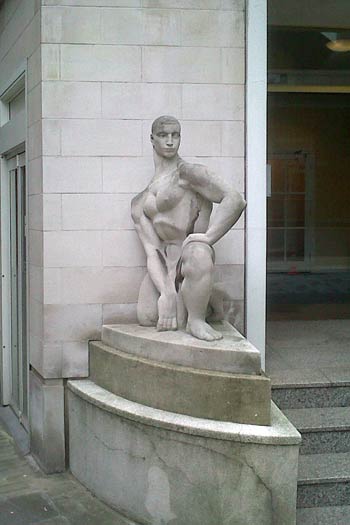 In 2009 it was announced that a sculpture of 3 figures (a group of newspapermen) had been relocated to a City garden after being unceremoniously removed from its original home in New Street Square. This sculpture dated from 1956/8 and was by the sculptor Wilfred Dudeney. Less remarked upon was the fact that a related piece, a Figure of Youth, remained in situ at the entrance to Pemberton House, facing East Harding Street. This is of slightly earlier date (1955).
In 2009 it was announced that a sculpture of 3 figures (a group of newspapermen) had been relocated to a City garden after being unceremoniously removed from its original home in New Street Square. This sculpture dated from 1956/8 and was by the sculptor Wilfred Dudeney. Less remarked upon was the fact that a related piece, a Figure of Youth, remained in situ at the entrance to Pemberton House, facing East Harding Street. This is of slightly earlier date (1955).
Why History?
In 1976 I arrived from my country grammar school at the Historical shrine of Peterhouse. At the time, although the smallest of the colleges of Cambridge, it had the highest number of History dons.
The study of History was taken seriously and the effect on me was to be lifelong. The key people for me were Maurice Cowling and Brian Wormald. Sitting in front of these strange, intense men reading an undergraduate essay was profoundly challenging. Historical writing involved seeking to understand the reality behind why men acted in the way they did; and that reality was hugely complex and not to be confused with the descriptions of it in the work of historians. For those writing about the past always have an agenda. The identification and evaluation of that agenda is part of the reader’s challenge. The effort to abandon – or at least admit to – that agenda is part of the historian’s challenge.
Wilfred Dudeney
Art in Northern Ireland (3)
The Ulster Museum in Belfast has a fine collection of 20th century British art,which is well worth seeing,especially for the English tourist who will find works by these artists rare in England.There are,for example,astonishing works by the great John Luke (1906-1975).There is also a small sculpture section,including a major piece by Henry Moore.
Across the road from the Museum is a cafe located in the studio of the artist,William Conor (1881-1968).
Another great work by Luke is an unexpected find in the small Armagh Museum.This is a well-known picture called The Old Callan Bridge.
Finally,on to Enniskillen,and there a blue plaque indicates the house where William Scott lived.His father was from Enniskillen,but by the time Scott was born in 1913,the family was living in Greenock in Scotland,returning to Enniskillen in 1924.So he is sometimes treated as a Northern Irish artist and sometimes as a Scot.I am not aware if any of his work survives in the town.
Art in Northern Ireland (2)
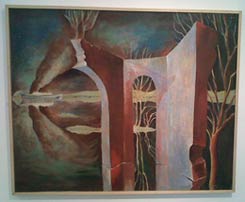 The exhibition of Irish Surrealist Art at the FE McWilliam Gallery in Banbridge had a variety of interesting pictures. I want to mention two.
The exhibition of Irish Surrealist Art at the FE McWilliam Gallery in Banbridge had a variety of interesting pictures. I want to mention two.
Ralph Cusack (1912-1965) is an artist whose work one will wait a long time before glimpsing. It very rarely comes through the saleroom. He is a curiosity rather than a substantive artist,perhaps. Readers may know something about him if they have read that wonderful book by Anthony Cronin,”Dead as Doornails”. Anyone interested in the cultural life of 20th C Ireland would enjoy that book and it has a story about Mr Cusack which will encourage curiosity.
The other artist whose work is shown here, Beatrice, Lady Glenavy,(1881-1970), is more like the real thing. She attended the Dublin School of Art and was taught by Orpen. Her work is fascinating and original. 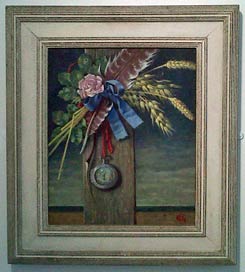 It does come through the salerooms from time to time and is worth keeping an eye out for. (One of her claims to fame was that she was the mother of Patrick Campbell, who later became 3rd Baron Glenavy, and who was popular for years on Call My Bluff on TV.) There was another, sensational picture by her at the show currently on at the Ava Gallery at Clandeboye, seat of the Marquess of Dufferin and Ava and now home to his widow. This one was a picture of an owl and in some ways stole the show amongst so many great artists. The gallery is well worth a visit. I was even able to buy a copy of Dickon Hall’s book on Colin Middleton, which is not easy to come by in England.
It does come through the salerooms from time to time and is worth keeping an eye out for. (One of her claims to fame was that she was the mother of Patrick Campbell, who later became 3rd Baron Glenavy, and who was popular for years on Call My Bluff on TV.) There was another, sensational picture by her at the show currently on at the Ava Gallery at Clandeboye, seat of the Marquess of Dufferin and Ava and now home to his widow. This one was a picture of an owl and in some ways stole the show amongst so many great artists. The gallery is well worth a visit. I was even able to buy a copy of Dickon Hall’s book on Colin Middleton, which is not easy to come by in England.
Mention of Middleton reminds me of a surprise sighting of a rather lovely picture by him on the upstairs landing in another grand Irish house, Florence Court in County Fermanagh. Seat of the Earls of Enniskillen, but in the hands of the National Trust since the 1950’s, it was completely out of context in a house which contained nothing else of that type. A note on the picture explained that it had arrived at the house during the period of the NT’s ownership, which explains its presence there. As I was looking at it the man next to me said that it was by van Gogh, which would have been an even more unlikely find.
Art in Northern Ireland (1)
It is a theme of mine that the London art world has shamefully ignored the achievements of the group of mid-century artists who came out of Northern Ireland and it is high time they got their just deserts in terms of UK recognition.
This group is probably led by Gerard Dillon, but there are strong claims to importance from the amazing work of John Luke, the extraordinary variety of accomplished work by Colin Middleton and the moody romantic work of Daniel O’Neill. That is not to forget the work of George Campbell and Arthur Armstrong and Norah McGuinness. And that is before one considers the fascinating work of Sine Mackinnon and the more recent work of Basil Blackshaw.
But I haven’t mentioned the great sculptor of Northern Irish 20th century art, FE McWilliam, and this is an oversight.
A few weeks ago, whilst driving up the main road from Dublin to Belfast, I completely unwittingly noticed a sign to the FE McWilliam Gallery in Banbridge. The penny dropped immediately in that I knew he came from there, but I was appalled to admit that I had no idea that there was a gallery dedicated to him. And what a gallery it is. It has an excellent exhibition space, currently showing Irish Surrealist Art, outdoor sculptures by McWilliam and others and a Moore-like recreation of his studios. And a café. All in all, a marvellous find and one which does huge credit to the people of Banbridge and to the art establishment of Northern Ireland (and the McWilliam family).
Here are some pictures, and a link to the gallery website.

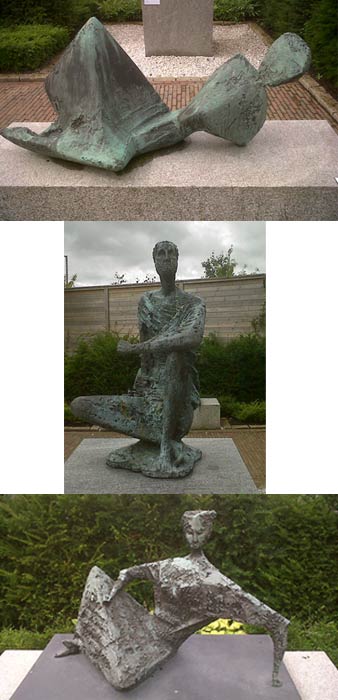
Stanley Spencer at Compton Verney
Compton Verney in Warwickshire is really proving a tremendous attraction for anyone interested in 20th C British art.Now there is a fascinating show of Spencer’s landscape art.One never sees these pictures together,although occasionally the odd one passes through the sale rooms.They don’t make such enormous prices as the more “typical” Spencers,such as the ones sold at the sale of Wilfrid Evill’s collection at Sotheby’s recently.And a liking for the religious pictures might mean that one likes these less.But in fact,my view of Spencer is that he is right up there near or alongside Bacon as one of the pre-eminent British artists of the century.Whilst these pictures are,perhaps,more “charming” than the religious ones,they are often freighted with symbolism and meaning.
Spencer was a powerful,visionary thinker/artist.When he painted the new concrete posts in the new back gardens of the little houses disfiguring his beloved Cookham,he seems to have seen the crosses marking the desolation of a First World War cemetry.When he painted in minute detail the growing vegetation climbing up and around a house facade,he was seeing some triumph of the natural world over the mere works of man.So there is nothing merely pretty about these works.They are well worth the trip up the M40.One can even see the newly re-thatched ice house along the drive up to the house.
Now one is looking forwards even more to the big Spencer show in Rotterdam,which starts in September.
Mark Gertler
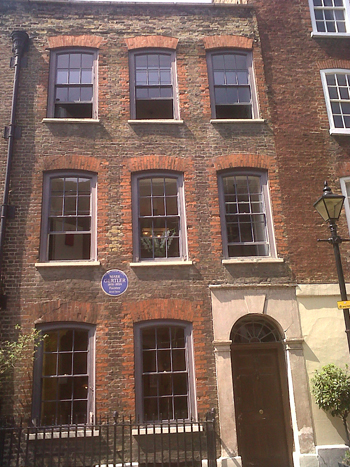 On the edge of the City is the attractive Elder Street. Now gentrified, it was no doubt a little more down at heel in the late 19th century, when Mark Gertler lived there at number 32. My office is 5 minutes’ walk away.
On the edge of the City is the attractive Elder Street. Now gentrified, it was no doubt a little more down at heel in the late 19th century, when Mark Gertler lived there at number 32. My office is 5 minutes’ walk away.
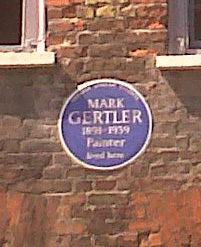
Philip Lindsey-Clark
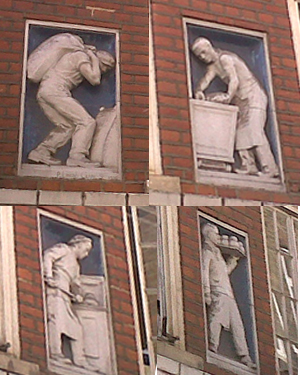 In Widegate Street on the Spitalfields edge of the City are 4 attractive ceramic panels in a row at first floor level of a small brick building. They are white on a blue base and show various aspects of the baker’s work. Presumably when they were put on the building it was a bakery. One is signed by Lindsey-Clark and dated 1926. His dates were 1889-1977. His father was also a sculptor.
In Widegate Street on the Spitalfields edge of the City are 4 attractive ceramic panels in a row at first floor level of a small brick building. They are white on a blue base and show various aspects of the baker’s work. Presumably when they were put on the building it was a bakery. One is signed by Lindsey-Clark and dated 1926. His dates were 1889-1977. His father was also a sculptor.
Scotney Castle Gardens, Kent
In the incredibly beautiful and romantic gardens around Scotney is a Henry Moore sculpture. According to the plaque, it was given by Moore to Christopher Hussey, the great architectural historian who owned Scotney.
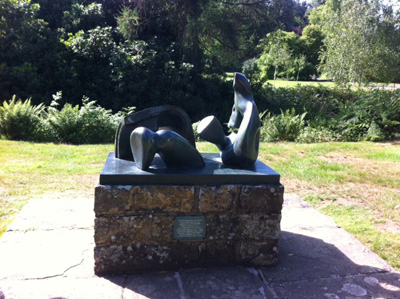
The distribution of 20th century sculpture around the country is something which merits attention. (In London it is hard to escape Paolozzi.) I will continue to highlight examples and see where we get to.
